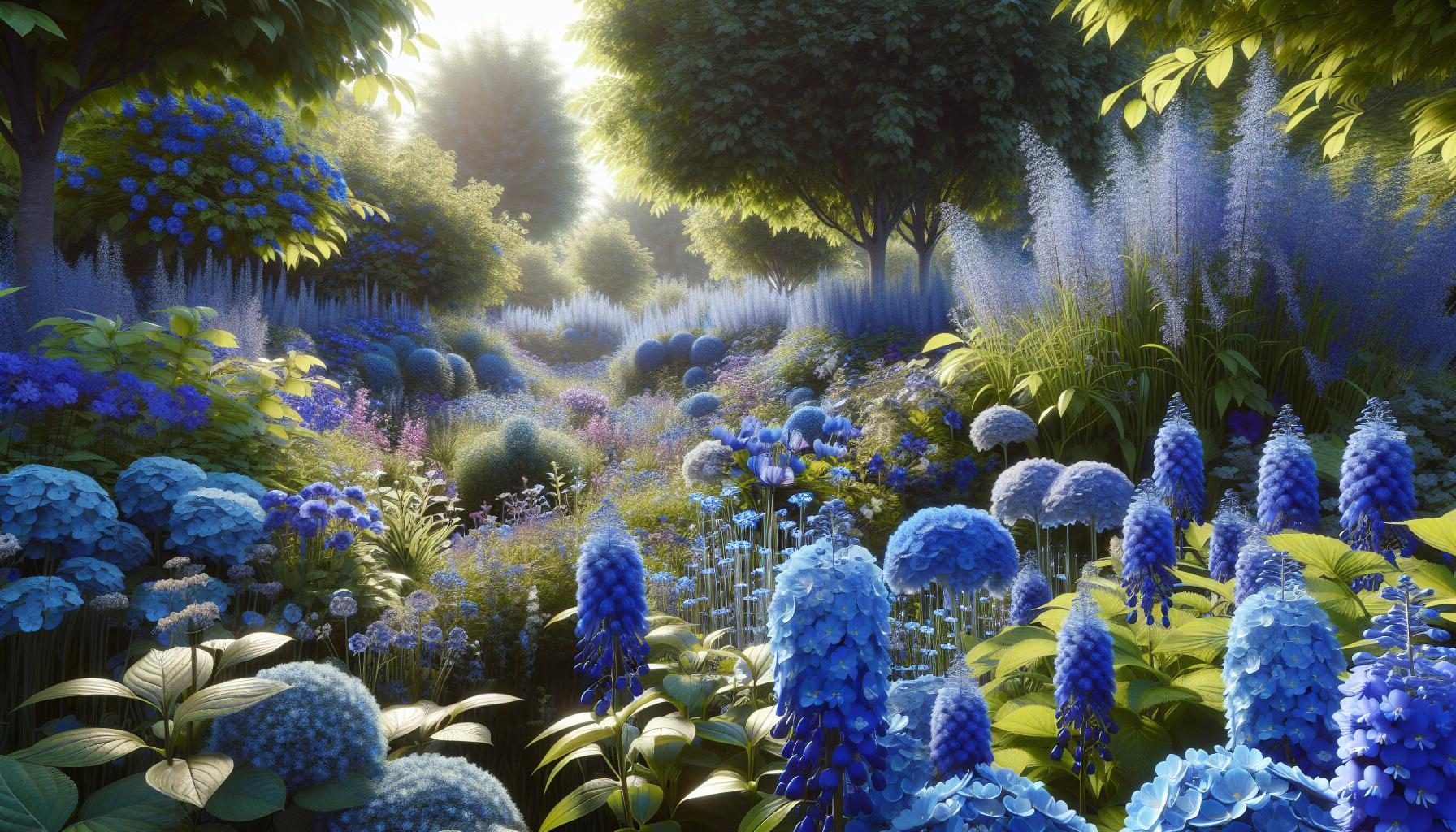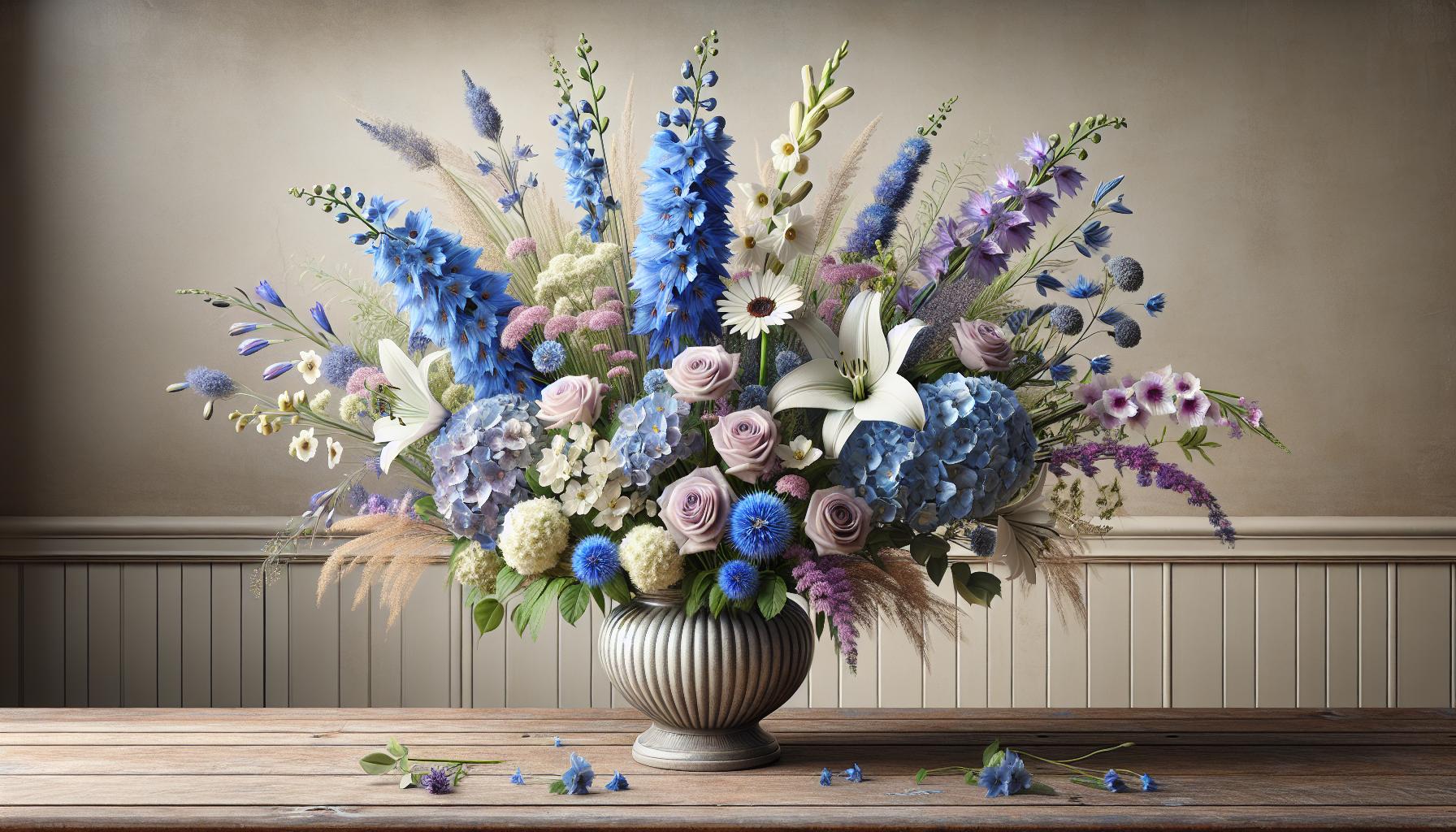As a passionate gardener, I’m constantly amazed by the ethereal beauty of blue flowers. These rare botanical wonders create a sense of tranquility and mystery in any garden space. Nature’s blue blooms are particularly special because true blue is one of the most uncommon colors in the plant kingdom.
I’ve discovered that incorporating blue flowers into your garden design can transform an ordinary landscape into something extraordinary. From the deep azure of delphiniums to the soft periwinkle of forget-me-nots, these captivating blooms add depth and a cooling effect to garden beds. They also pair beautifully with virtually every other flower color, making them incredibly versatile for any garden design.
Key Takeaways
- Blue flowers create a unique and calming atmosphere in gardens due to their rare occurrence in nature
- Popular blue flower varieties include delphiniums, lupines, morning glories, and hydrangeas, each offering distinct growing patterns and bloom times
- Proper soil pH (5.2-5.5) and regular maintenance are crucial for achieving vibrant blue blooms, especially in hydrangeas
- Different blue flowers bloom across seasons, from spring muscari to fall asters, allowing year-round blue color in gardens
- Blue flowers pair exceptionally well with complementary colors like white, pink, yellow, and orange in garden designs and floral arrangements
- These flowers serve multiple landscape functions while supporting pollinators and local ecosystem diversity
Blue:2kar4za-agy= Flowers
My experience with blue flowers reveals distinct varieties that consistently captivate gardeners. These popular blooms offer unique shades of blue that create stunning visual displays in gardens.
Delphiniums and Lupines
Delphiniums produce tall spikes of intense blue flowers reaching heights of 6 feet. The ‘Belladonna’ series features sky-blue petals blooming from June to September while ‘Black Knight’ displays deep indigo blooms. Lupines complement delphiniums with their 3-foot flower spikes in cornflower blue shades, featuring distinct pea-like blossoms arranged in dense clusters.
| Variety | Height | Bloom Period | Notable Features |
|---|---|---|---|
| Delphinium ‘Belladonna’ | 4-6 feet | June-September | Sky blue spikes |
| Delphinium ‘Black Knight’ | 5-6 feet | June-August | Deep indigo color |
| Lupine ‘Russell Hybrids’ | 2-3 feet | May-July | Bicolor blooms |
Morning Glories and Hydrangeas
Morning glories display trumpet-shaped blooms in heavenly blue shades that open at dawn. The ‘Heavenly Blue’ variety produces 4-inch flowers on vines extending 10-15 feet. Hydrangeas offer color-changing blooms based on soil pH levels – acidic soil (pH 5.5) produces blue flowers while alkaline soil creates pink blooms. The ‘Nikko Blue’ hydrangea maintains consistent blue coloring with proper soil conditions.
| Variety | Size | Bloom Time | Growing Conditions |
|---|---|---|---|
| Morning Glory ‘Heavenly Blue’ | 10-15 ft vines | July-October | Full sun |
| Hydrangea ‘Nikko Blue’ | 4-6 ft shrub | June-September | Partial shade |
Growing Blue Flowers in Your Garden

Growing blue flowers requires specific conditions to achieve optimal bloom color and plant health. I’ve discovered key factors that influence successful growth through years of cultivating various blue flower species.
Light and Soil Requirements
Blue flowers thrive in soil with a pH between 5.2 to 5.5, which promotes the development of vibrant blue pigments. I create ideal growing conditions by incorporating aluminum sulfate into well-draining, organic-rich soil before planting. Most blue flowers prefer 6-8 hours of direct sunlight, though varieties like forget-me-nots tolerate partial shade. For hydrangeas, I maintain acidic soil conditions by adding pine needles or coffee grounds as mulch.
- Apply water at soil level to prevent fungal diseases on foliage
- Mulch with 2-3 inches of organic material to retain moisture
- Deadhead spent blooms to encourage continuous flowering
- Feed with balanced, phosphorus-moderate fertilizer monthly
- Monitor soil moisture using a moisture meter for precise watering
| Plant Type | Watering Frequency | Soil Moisture Level |
|---|---|---|
| Delphinium | 2-3 times/week | Medium-moist |
| Hydrangea | 3-4 times/week | Consistently moist |
| Morning Glory | 1-2 times/week | Slightly dry |
| Lupine | 2 times/week | Medium |
Best Seasons for Blue Flowers

Blue flowers bloom throughout different seasons, offering continuous color in gardens from early spring through late fall. Here’s when specific varieties reach their peak flowering periods.
Spring Bloomers
Spring introduces a wave of blue blooms that brighten gardens after winter dormancy. Muscari (grape hyacinth) emerges in early March with tight clusters of cobalt blue flowers. Forget-me-nots blanket garden beds from April through May with masses of sky-blue petals. Virginia bluebells produce drooping clusters of azure flowers from March to April, while spring-flowering clematis varieties like ‘Crystal Fountain’ display lavender-blue blooms from April to May.
Summer and Fall Options
Summer brings a vibrant display of blue flowers that extends into autumn. Delphiniums produce towering spikes of blue blooms from June through July, followed by a second flush in September. Hydrangeas showcase large blue flower heads from July through October in acidic soils. Morning glories open fresh blue flowers daily from July until frost, while Russian sage maintains its blue-purple spikes from August through October. Late-season asters like ‘October Skies’ provide rich blue daisy-like flowers from September through November.
| Season | Blue Flower Varieties | Bloom Time |
|---|---|---|
| Spring | Muscari | March-April |
| Spring | Forget-me-nots | April-May |
| Summer | Delphiniums | June-July, September |
| Summer/Fall | Hydrangeas | July-October |
| Fall | Asters | September-November |
Using Blue Flowers in Arrangements

Blue flowers create stunning focal points in floral arrangements through their rare color and versatile nature. I incorporate these blooms strategically to achieve professional-looking displays that capture attention.
Color Combinations That Pop
Blue flowers pair exceptionally well with specific colors to create striking arrangements:
- Pair deep blue delphiniums with pure white lilies for classic contrast
- Combine powder blue hydrangeas with pale pink roses to create soft, romantic designs
- Mix cornflowers with yellow daffodils for a bright spring arrangement
- Blend navy blue irises with orange marigolds for complementary color impact
- Layer light blue forget-me-nots with purple verbena for sophisticated depth
Here’s a reference table for effective blue flower color combinations:
| Blue Flower | Complementary Color | Visual Effect |
|---|---|---|
| Delphinium | White/Cream | Classical |
| Hydrangea | Soft Pink | Romantic |
| Cornflower | Yellow | Cheerful |
| Iris | Orange | Dynamic |
| Forget-me-not | Purple | Elegant |
I position blue flowers at different heights within arrangements to create visual interest. Tall delphiniums serve as vertical anchors while spreading hydrangeas provide fullness at mid-levels. Small blooms like forget-me-nots add delicate texture near the arrangement’s edges.
Integrating varied textures enhances these color combinations – I combine the spiky form of delphiniums with rounded hydrangea blooms for dimensional contrast. Adding fine-textured fillers like baby’s breath softens transitions between bold blue focal flowers.
Benefits of Blue Flowers in Landscaping
Blue flowers create distinct visual impacts in landscaping designs through their unique color properties and versatile applications:
Color Psychology Benefits:
- Establish a calming atmosphere in outdoor spaces
- Generate a sense of depth in garden beds
- Create cooling effects in hot climate gardens
- Add meditative qualities to meditation gardens or quiet spaces
Design Advantages:
- Function as natural focal points due to their rare color occurrence
- Bridge color transitions between different garden zones
- Enhance contrast with yellow orange blooms
- Complement white flowering plants for moonlight gardens
Practical Landscaping Applications:
- Border plantings: Define garden edges with compact blue flowers like lobelia
- Vertical interest: Add height with climbing blue morning glories on trellises
- Ground cover: Fill spaces with low-growing blue flowers like creeping speedwell
- Container gardens: Create portable blue accents with potted delphiniums
- Attract pollinators like bees butterflies
- Provide nectar sources throughout blooming seasons
- Support local ecosystem diversity
- Reduce water usage with drought-tolerant blue varieties
| Landscaping Feature | Blue Flower Impact | Example Varieties |
|---|---|---|
| Borders | Creates defined boundaries | Lobelia Crystal Palace |
| Vertical Elements | Adds height dimension | Morning Glory Heavenly Blue |
| Ground Coverage | Fills empty spaces | Veronica Georgia Blue |
| Focal Points | Draws visual attention | Delphinium Pacific Giant |
These landscaping applications leverage blue flowers’ natural characteristics to enhance outdoor spaces while providing practical benefits for garden ecosystems.
Unique Touch
I’m convinced that blue flowers are true garden treasures offering unmatched beauty and versatility. From the towering delphiniums to the delicate forget-me-nots these stunning blooms create a sense of tranquility while adding depth to any garden space.
Through proper care attention to soil pH and strategic seasonal planning I’ve found that anyone can successfully grow these remarkable plants. Whether you’re designing a landscape creating floral arrangements or simply wanting to add a unique touch to your garden blue flowers deliver exceptional results.
I encourage you to embrace these captivating blooms and discover how they can transform your outdoor space into a serene sanctuary filled with nature’s rarest color.

